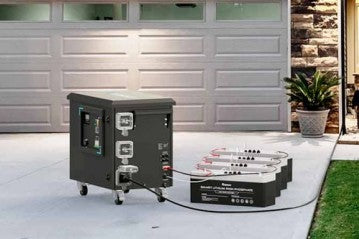
Solar inverters are an essential component of a solar power system. As solar power systems become more intelligent and interact more with the utility grid, the role of inverters continues to grow. In this article, we will introduce you to the basics of solar inverters, including what they are, how they work, and how to choose the right inverter for your solar power system.
1. What is a Solar Inverter?
A solar inverter, also known as a photovoltaic (PV) inverter, is an electronic device that converts the DC power generated by solar panels into AC power. It is an essential component of any solar power system, as it ensures that the electricity generated by the solar panels is compatible with the electrical grid and can be used to power homes and businesses.
2. How Does a Solar Inverter Work?
A solar inverter works by converting the DC power generated by the solar panels into AC power that can be used to power homes and businesses. It does this using a process called inversion, which involves converting the DC power into AC power that is compatible with the electrical grid.
The process of inversion involves several stages. First, the DC power generated by the solar panels is fed into the inverter. The inverter then converts this DC power into AC power using a process called pulse width modulation (PWM). PWM involves rapidly switching the DC power on and off, which creates a waveform that is similar to AC power. This waveform is then filtered and smoothed to create a clean, stable AC power output.
The solar inverter also performs several other important functions, including monitoring the performance of the solar panels and ensuring that the output voltage and frequency are compatible with the electrical grid. It also includes safety features that protect the system from overvoltage, undervoltage, and other electrical faults.
3. How to Choose the Right Inverter?
Choosing the right inverter for your solar power system is essential to ensure that it performs at maximum efficiency and produces the most energy possible. Here are three steps to help you choose the right inverter for your system:
Step 1: Identify Your Power Requirements
The first step in choosing the right inverter is to identify your power requirements. This will depend on the size of your solar power system and the amount of electricity you need to power your home or business.
You can calculate your power requirements by adding up the wattage of all the electrical appliances and devices you use and multiplying this by the number of hours you use them each day. For example, if you have a washing machine, a TV and two computers, each with a wattage of 300, 100 and 150 watts, then the total wattage you need is (300+100+150*2) = 700 watts.
Step 2: Check the VA Rating of the Inverter
The VA rating of the inverter is an important factor to consider when choosing the right inverter for your solar power system. The VA rating is a measure of the inverter's capacity to handle the maximum load of your electrical appliances and devices.
VA = Power Requirement/Power Factor
It is important to choose an inverter with a VA rating that is equal to or greater than your power requirements, which can be determined by dividing the total power requirement (in watts) by the power factor. If the power factor is 0.8, combined with the example above, then the required VA rating is 700/0.8 = 875 VA.
Step 3: Get an Appropriate Battery for the Inverter
If you are planning to use an inverter to power your home or business during a power outage, it is important to choose an appropriate battery that can provide the necessary backup power. The size and type of battery you need will depend on your power requirements and the duration of the outage. It is important to choose a battery that is compatible with your inverter and can provide the necessary backup power.
In conclusion, When choosing the right solar inverter for your solar power system, it is important to consider your power requirements, the VA rating of the inverter, and the type of battery you need for backup power. By following these steps, you can ensure that your solar power system performs at maximum efficiency and produces the most energy possible.

0 comments